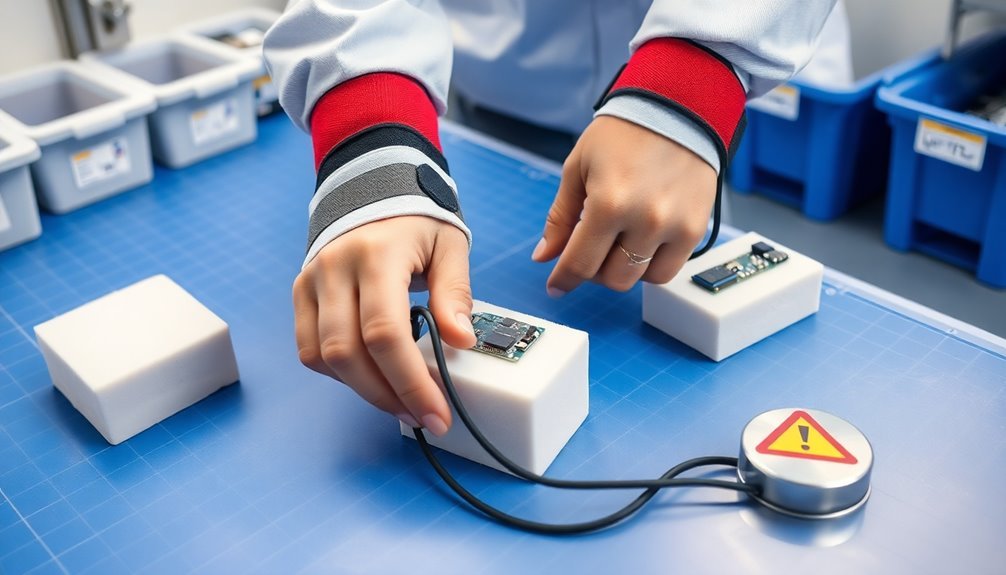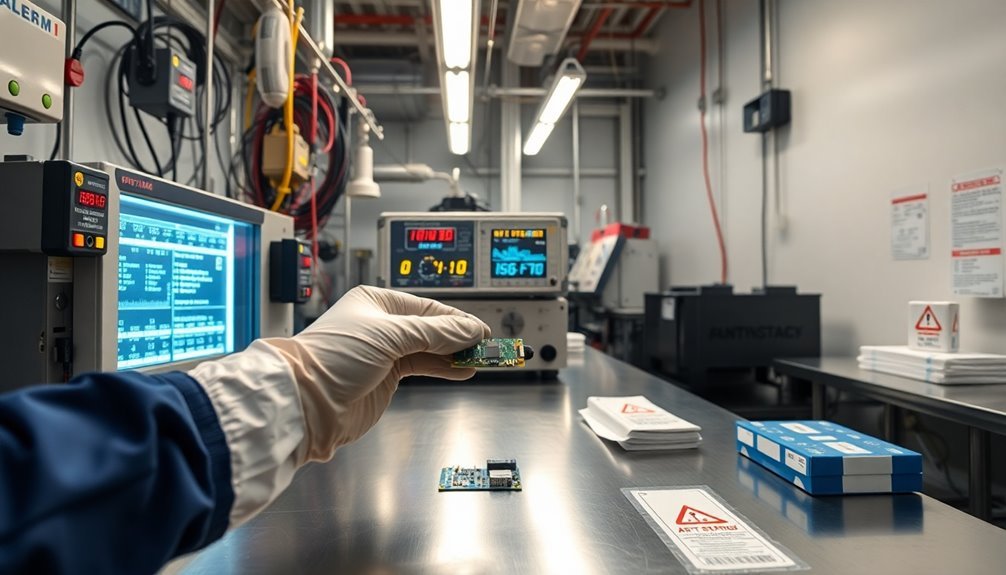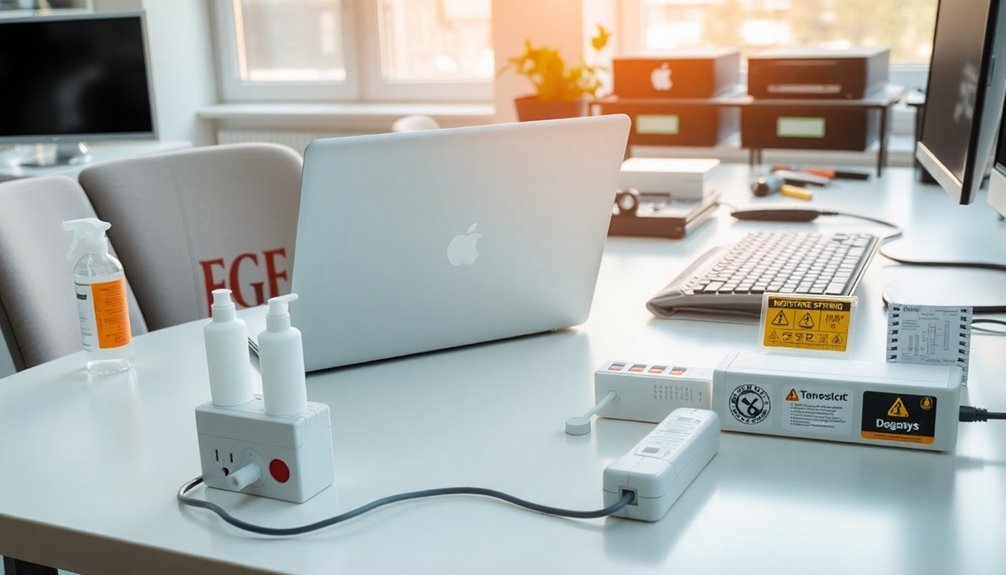Workplace electronics protection rules guarantee you're following proper ESD (electrostatic discharge) safety protocols when handling sensitive equipment. You'll need proper workstation setups with antistatic mats, common point grounding systems, and personal protective equipment like wrist straps and ESD-safe clothing. You must maintain environmental controls, including humidity levels and ionization, while implementing clear warning signs and controlled access procedures. You'll also need regular training, compliance audits, and proper documentation of all safety measures. The thorough requirements reflect just how vital proper electronics handling is for workplace safety and equipment protection.
Required ESD Safety Equipment

Setting up a proper ESD workstation calls for essential safety equipment to protect sensitive electronic components. You'll need to start with a dissipative or antistatic work surface that prevents charge buildup while handling components.
A common point ground system must be installed to effectively channel static electricity away from your workspace.
For personal protection, you'll need to wear a wrist strap whenever you're performing sedentary tasks. Your workstation should include static-dissipative flooring to prevent charge generation as you move around.
Low humidity conditions can greatly increase the risk of static charge accumulation, so maintaining proper environmental controls is crucial. You must also use ESD-safe gloves and finger cots made from static-dissipative materials when handling sensitive components directly.
You'll need to outfit yourself with appropriate ESD protective clothing, including static-dissipative smocks worn as outer garments and ESD-safe shoes with dissipating soles.
Remember that common items like coffee cups and regular adhesive tapes are prohibited at your workstation as they can generate static charges.
Your workspace must be clearly marked with ESD warning signs, and you should maintain controlled access to guarantee only properly equipped and trained personnel enter the area.
Static Control Program Implementation
With your ESD safety equipment in place, you'll need a structured approach to implement a complete static control program. Start by preparing your facility through thorough audits of high-risk areas and installing proper grounding systems. You'll need to guarantee all workstations use ESD-safe materials and incorporate appropriate storage solutions for sensitive components. It is crucial to engage in knowledge sharing practices to maintain consistent safety standards across all departments.
| Implementation Phase | Key Actions | Verification |
|---|---|---|
| Facility Setup | Install grounding systems, ESD-safe workbenches | Daily testing of grounds |
| EPA Establishment | Remove non-conductors, install ionizers | Weekly EPA inspections |
| Program Management | Train staff, maintain documentation | Monthly compliance audits |
Your implementation must follow a thorough ESD control plan that aligns with ANSI/ESD S20.20 standards. You'll need to establish an ESD Protected Area (EPA) where you'll control static electricity through proper grounding and the use of dissipative materials. Don't forget to replace non-conducting materials with static-dissipative alternatives wherever possible. To maintain program effectiveness, you'll need to verify compliance regularly, conduct periodic audits, and guarantee all personnel receive proper training. Keep detailed records of your control measures and consistently monitor your practices for potential improvements.
Personnel Training Requirements

You'll need to undergo annual training updates to stay current with your workplace's electrical safety compliance standards and policies.
Arc flash hazards and their prevention are essential components of the required training curriculum.
Your participation in these sessions guarantees you're equipped with the latest safety protocols and operational procedures for handling electronic equipment.
Regular policy implementation training helps you maintain safe work practices and understand any modifications to existing safety guidelines.
Annual Compliance Updates
In accordance with federal and state regulations, all personnel must complete annual training on workplace electronics protection policies. You'll need to stay current with the NLRB's requirements and your state's specific laws regarding electronic monitoring in the workplace. States like Connecticut, Delaware, New York, and Texas have implemented distinct protocols for workplace monitoring notices.
You must guarantee your organization conducts regular audits and maintains clear documentation of all training sessions. The Stored Communications Act permits employers to access company email systems when monitoring policies are properly disclosed.
Your compliance updates should address device security measures, including password protection protocols and automatic screen locking procedures. If you're using company devices on public WiFi networks, you'll need to follow established guidelines for safe online access.
Monitoring practices require proper notice posting in many states, and you'll need written consent from employees where mandated. You must also maintain clear protocols for reporting lost or stolen devices.
The penalties for non-compliance can include significant fines and civil damages, so it's vital to keep up with changing labor laws. Remember to review and update your electronic communications policies annually to reflect technological advances and new regulatory requirements.
Policy Implementation Training
Through extensive training programs, employees must demonstrate proficiency in workplace electronics protection policies. You'll need to participate in classroom, on-the-job, and online sessions tailored to your specific job duties and risk exposure. Training content must align with OSHA 1910.332 regulations and cover essential safety protocols, including lockout/tagout procedures. Prior to implementing any algorithmic management systems, employers must provide comprehensive training on their use and potential impacts. Your employer's responsibilities include developing thorough training programs and making certain you have access to written safety procedures. They'll assign qualified supervisors to evaluate your understanding and maintain precise records of your training completion.
| Training Component | Requirements |
|---|---|
| Methods | Classroom, online, hands-on |
| Content Coverage | OSHA standards, safety protocols |
| Assessment | Proficiency testing, evaluations |
| Documentation | Accurate records, audit readiness |
You'll need to complete interactive assessments to demonstrate your understanding of safety procedures. Your training will be delivered through learning management systems that maintain consistent, up-to-date content. Remember, your level of training depends on your job responsibilities and exposure to electrical hazards. As regulations and industry practices evolve, you'll participate in ongoing training updates to maintain compliance and safety standards.
Workstation Design Standards
Establishing a properly designed ESD workstation demands careful attention to both safety and functionality standards. You'll need to implement a thorough grounding system where all components connect to a single common point ground, using a two-step process to safeguard protection. Regular testing with ESD equipment testers ensures all protective measures remain effective.
Your workspace must feature static-dissipative surfaces and ESD mats to prevent charge buildup, while proper grounding equipment like wrist straps and heel grounders keeps personnel safely connected to ground.
You must position your workstation within a designated Electrostatic Protected Area (EPA), clearly marked with visible floor tape. The area should have conductive or dissipative flooring that allows charges to safely dissipate.
Don't forget to equip your station with essential accessories like ESD-safe tools, static shielding bags, and proper waste disposal containers. You'll also need monitoring equipment to regularly test the effectiveness of your grounding systems and protective gear.
For ongoing protection, you must maintain ESD ionizers to neutralize static on insulators and consistently evaluate your control measures. Remember to keep ESD-sensitive components isolated from non-ESD activities and safeguard that all personnel wear appropriate protective gear, including ESD jackets when necessary.
Testing and Certification Methods

Testing electronics demands a multi-faceted approach encompassing function-based, system-based, ESD, and ingress protection methods.
In function-based testing, you'll need to model your device to predict its behavior based on various settings, selecting multiple test points to measure relay responses. The software model must match the device's protection algorithm, though modern devices' overlapping functions can make testing complex. Hybrid digital/electronic devices emerged in the 1980s to combine microprocessors with solid-state circuitry.
System-based testing requires you to model the entire power system, including scenarios like faults and voltage transients. You'll map test channels to protection devices and execute scenarios to measure responses, providing a thorough evaluation of real-world conditions.
For ESD protection, you must test devices using the Human Body Model and follow specific setup configurations to guarantee they can handle high-voltage electrical pulses safely.
You'll need to conduct ingress protection testing using standards like IP67 to verify your devices can withstand environmental factors. This includes air leak testing to detect microscopic holes, water submersion tests, and humidity exposure in controlled chambers.
These combined testing methods guarantee your workplace electronics meet safety and reliability requirements while protecting both equipment and personnel.
Monitoring and Compliance Procedures
A thorough monitoring and compliance framework guarantees your workplace electronics meet both federal and state regulations. You'll need to comply with federal laws like the Electronic Communications Privacy Act while also following state-specific requirements for electronic monitoring.
You must provide written notice to your employees about any monitoring activities you're implementing. This includes detailing how you'll track company emails, phone calls, and internet usage on business devices.
For effective organization of compliance documentation, create vertical headings lists in your monitoring policies for easy reference. Remember that you can't monitor personal devices without explicit consent, and your monitoring must serve legitimate business purposes.
If you're operating in New York, you'll face specific requirements, including visible workplace notices about electronic monitoring and signed acknowledgments from employees. Violations can result in escalating fines starting at $500. You can post these notices physically or display them during computer login.
To maintain compliance, you'll need to regularly review and update your monitoring policies. It's crucial to obtain written or electronic acknowledgments from both new and current employees.
Your monitoring software should only track business communications and company-owned devices to stay within legal boundaries.
Device Handling Best Practices

You'll need to implement strict data storage protocols on your devices, including password protection, encrypted files, and regular backups of work-related information.
When using workplace electronics, you must follow proper safety procedures by keeping cables organized, maintaining clear pathways around equipment, and returning devices to designated storage areas after use.
Your consistent adherence to both data security measures and physical safety protocols helps protect sensitive information while preventing workplace accidents.
Secure Data Storage Guidelines
In accordance with modern data security standards, protecting sensitive information requires thorough device handling practices that align with your organization's data classification policies.
You'll need to implement thorough security controls that cover both physical and digital protection of your data assets. This includes using role-based access control, strong authentication mechanisms, and regular security audits to guarantee compliance.
1. Encrypt your sensitive data both in transit and at rest, guaranteeing you're using appropriate encryption methods and maintaining secure key management systems.
You'll want to verify that your cloud storage providers meet the required encryption standards for your data sensitivity level.
2. Establish robust physical security measures by implementing card access systems, surveillance cameras, and secure workstation configurations.
Don't forget to maintain proper environmental controls for your data storage facilities.
3. Monitor and log all data access and modifications through authentication controls.
You should enforce strong password policies and implement multi-factor authentication where necessary to protect against unauthorized access.
Device Usage Safety Rules
Proper handling of workplace electronic devices starts with understanding fundamental safety protocols that protect both equipment and personnel. You'll need to carefully manage electrical cords by pulling from the plug head rather than the cord itself, and never use staples to secure cords or hang equipment from them. Before using any device, visually inspect cords and plugs for damage.
When working with electrical equipment, maintain appropriate distance from components operating above 50V and make certain all panel doors remain closed. If you're performing overhead work, use non-conductive ladders and stay at least 10 feet from exposed electrical lines.
| Safety Action | Key Requirement |
|---|---|
| Cord Handling | Pull from plug head, not cord |
| Distance Safety | Keep 10+ feet from exposed lines |
| Panel Management | Keep all doors closed, use barriers |
| Equipment Inspection | Check cords/plugs before use |
You must also follow proper electronic monitoring guidelines, including receiving prior notice of monitoring that affects employment decisions. Any monitoring systems should collect minimal data and avoid recording off-duty activities or sensitive areas. Remember that monitoring data can't be used for employment decisions without independent verification and thorough documentation.
ESD Control Documentation Guidelines
Organizations must maintain thorough documentation of their ESD control procedures to effectively protect sensitive electronic devices.
Your ESD control program plan should encompass both administrative and technical requirements while clearly identifying the sensitivity levels of devices you'll be handling. You'll need to designate an ESD Program Manager who'll oversee the implementation and guarantee all documentation stays current.
Your documentation must include detailed specifications for your Electrostatic Protected Areas (EPA) and establish extensive grounding systems for personnel and equipment. You'll also need to maintain records of employee training and compliance verification to demonstrate your program's effectiveness.
Here are three critical components you must include in your ESD documentation:
- A written plan detailing all procedures and specifications for protecting ESD-sensitive items, including tailoring statements and rationale
- A Product Qualification Plan that outlines how you'll verify and approve ESD protective products
- A Compliance Verification Plan specifying measurement requirements, testing equipment standards, and audit procedures
Remember to keep your documentation aligned with industry standards like ANSI/ESD S20.20 and regularly update it based on risk assessments and changing device sensitivities.
Frequently Asked Questions
Can Employers Monitor Personal Devices Connected to Company Wifi Networks?
When you connect your personal device to company WiFi, employers can track your network activity and website visits, but they can't access your device's content or passwords without your explicit consent or a court order.
How Often Should Electronic Monitoring Policies Be Updated to Maintain Compliance?
You'll need to update your electronic monitoring policies annually, or whenever significant changes occur in monitoring practices. Be sure to review state-specific requirements and provide written notice to employees of any updates.
Are Employers Required to Delete Recorded Surveillance Footage After Specific Time Periods?
You'll need to follow your state's specific requirements for footage deletion. While there's no universal standard, you must establish clear retention policies based on legitimate business needs and applicable local laws.
Do Remote Workers Have Different Electronic Monitoring Rights Than On-Site Employees?
You'll generally have the same electronic monitoring rights whether working remotely or on-site. However, if you're using personal devices, you've got stronger privacy protections and can't be forced to install monitoring software.
Can Employees Opt Out of Specific Types of Electronic Monitoring?
You generally can't opt out of monitoring on company devices, but you can refuse monitoring on personal devices. Employers must respect your right to decline surveillance that isn't essential for business operations.
In Summary
You'll need to guarantee your workplace follows proper electronics protection protocols by implementing required safety equipment, establishing static control programs, and providing thorough training. Make sure your workstations meet design standards, conduct regular testing, and maintain detailed documentation. Don't forget to monitor compliance and follow device handling best practices to protect sensitive electronic components.





Leave a Reply